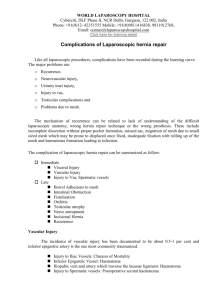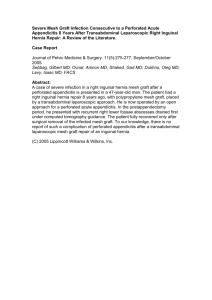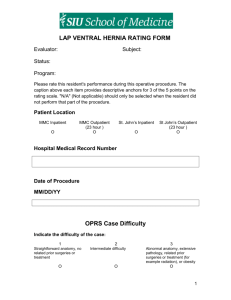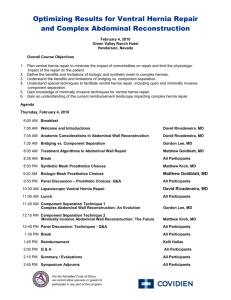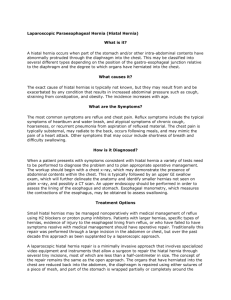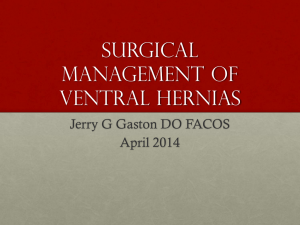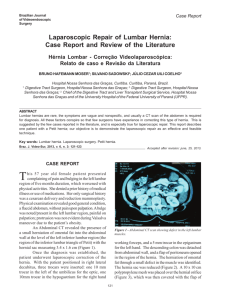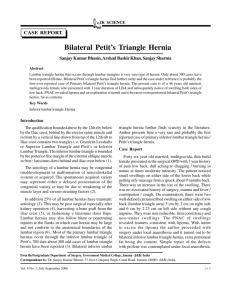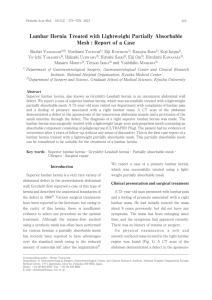Laparoscopic repair of a traumatic lumbar hernia repair
advertisement
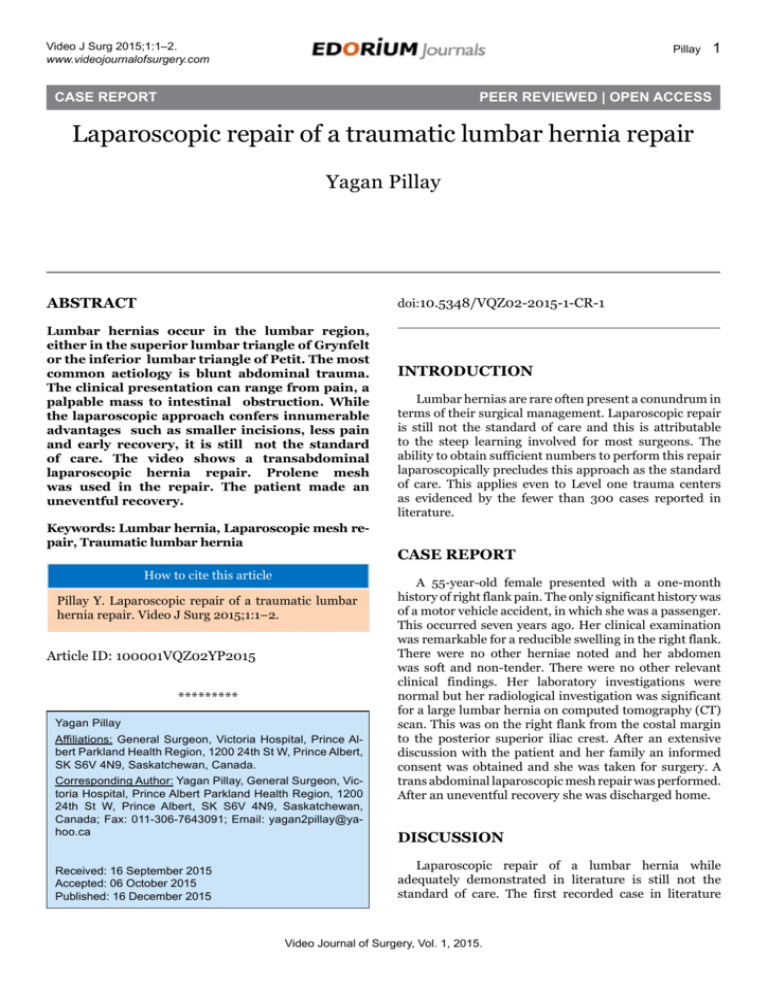
Video J Surg 2015;1:1–2. www.videojournalofsurgery.com Pillay 1 ACCESS case reportOPEN reportPeer Reviewed | OPEN ACCESS Laparoscopic repair of a traumatic lumbar hernia repair Yagan Pillay Abstract doi:10.5348/VQZ02-2015-1-CR-1 Lumbar hernias occur in the lumbar region, either in the superior lumbar triangle of Grynfelt or the inferior lumbar triangle of Petit. The most common aetiology is blunt abdominal trauma. The clinical presentation can range from pain, a palpable mass to intestinal obstruction. While the laparoscopic approach confers innumerable advantages such as smaller incisions, less pain and early recovery, it is still not the standard of care. The video shows a transabdominal laparoscopic hernia repair. Prolene mesh was used in the repair. The patient made an uneventful recovery. Keywords: Lumbar hernia, Laparoscopic mesh repair, Traumatic lumbar hernia How to cite this article Pillay Y. Laparoscopic repair of a traumatic lumbar hernia repair. Video J Surg 2015;1:1–2. Article ID: 100001VQZ02YP2015 ********* Yagan Pillay Affiliations: General Surgeon, Victoria Hospital, Prince Albert Parkland Health Region, 1200 24th St W, Prince Albert, SK S6V 4N9, Saskatchewan, Canada. Corresponding Author: Yagan Pillay, General Surgeon, Victoria Hospital, Prince Albert Parkland Health Region, 1200 24th St W, Prince Albert, SK S6V 4N9, Saskatchewan, Canada; Fax: 011-306-7643091; Email: yagan2pillay@yahoo.ca Received: 16 September 2015 Accepted: 06 October 2015 Published: 16 December 2015 iNTRODUCTION Lumbar hernias are rare often present a conundrum in terms of their surgical management. Laparoscopic repair is still not the standard of care and this is attributable to the steep learning involved for most surgeons. The ability to obtain sufficient numbers to perform this repair laparoscopically precludes this approach as the standard of care. This applies even to Level one trauma centers as evidenced by the fewer than 300 cases reported in literature. CASE REPORT A 55-year-old female presented with a one-month history of right flank pain. The only significant history was of a motor vehicle accident, in which she was a passenger. This occurred seven years ago. Her clinical examination was remarkable for a reducible swelling in the right flank. There were no other herniae noted and her abdomen was soft and non-tender. There were no other relevant clinical findings. Her laboratory investigations were normal but her radiological investigation was significant for a large lumbar hernia on computed tomography (CT) scan. This was on the right flank from the costal margin to the posterior superior iliac crest. After an extensive discussion with the patient and her family an informed consent was obtained and she was taken for surgery. A trans abdominal laparoscopic mesh repair was performed. After an uneventful recovery she was discharged home. DISCUSSION Laparoscopic repair of a lumbar hernia while adequately demonstrated in literature is still not the standard of care. The first recorded case in literature Video Journal of Surgery, Vol. 1, 2015. Video J Surg 2015;1:1–2. www.videojournalofsurgery.com Pillay was by Burick and Parascandola in 1996 [1]. This was a transabdominal approach. Woodward et al. described the first total extraperitoneal approach in 1999 with the use of a balloon dissector [2]. The laparoscopic approach has shown statistically significant lower morbidity rates, shorter hospital stay and an earlier return to work [3]. The largest hurdle to this repair remains the steep learning curve. Once this curve has been breached, however, the repair is a feasible one. This is shown by this video carried out in a rural hospital in Northern Saskatchewan, Canada by a general surgeon with no formal training in minimally invasive surgery. The long-term outcomes have also not been clearly evaluated and the optimal type of mesh used is also cause for debate [4, 5]. 2 Guarantor The corresponding author is the guarantor of submission. Conflict of Interest Authors declare no conflict of interest. Copyright © 2015 Yagan Pillay. This article is distributed under the terms of Creative Commons Attribution License which permits unrestricted use, distribution and reproduction in any medium provided the original author(s) and original publisher are properly credited. Please see the copyright policy on the journal website for more information. REFERENCES CONCLUSION Laparoscopic lumbar hernia repair is still not the standard of care despite better outcomes compared to open repair, due to the steep learning curve involved. This is also hampered by the difficulty in obtaining a sufficient number of cases as evidenced by the scarcity of cases in literature. ********* Author Contributions Yagan Pillay – Substantial contributions to conception and design, Acquisition of data, Analysis and interpretation of data, Drafting the article, Revising it critically for important intellectual content, Final approval of the version to be published 1. Burick AJ, Parascandola SA. Laparoscopic repair of a traumatic lumbar hernia: a case report. J Laparoendosc Surg 1996 Aug;6(4):259–62. 2. Woodward AM, Flint LM, Ferrara JJ. Laparoscopic retroperitoneal repair of recurrent postoperative lumbar hernia. J Laparoendosc Adv Surg Tech A 1999 Apr;9(2):181–6. 3. Moreno-Egea A, Torralba-Martinez JA, Morales G, Fernández T, Girela E, Aguayo-Albasini JL. Open vs laparoscopic repair of secondary lumbar hernias: a prospective nonrandomized study. Surg Endosc 2005 Feb;19(2):184–7. 4. Beth-Ann S, Victoriya Sara C, Kelly J, Joshua NH, Tomer D. Repair of a traumatic lumbar hernia with biosynthetic mesh:a novel approach and review of the literature. J Curr Surg 2012;2(3):105–9. 5. Sharma P. Lumbar Hernia. Med Journal of Armed Forces of India (MJAFI) 2009;64(2):178–9. Access full text article on other devices Access PDF of article on other devices Video Journal of Surgery, Vol. 1, 2015.


